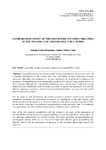Comparative study of the geometric incompatibilities in the dinamica of expandable structures

Use este enlace para citar
http://hdl.handle.net/2183/28214
A non ser que se indique outra cousa, a licenza do ítem descríbese como Atribución-Non comercial-Sen obra derivada 4.0
Coleccións
- Investigacion (ETSAC) [511]
Metadatos
Mostrar o rexistro completo do ítemTítulo
Comparative study of the geometric incompatibilities in the dinamica of expandable structuresData
2000-06-04Cita bibliográfica
López Hernández, Enrique y Manuel Muñoz Vidal. "Comparative study of the geometric incompatibilities in the dinamica of expandable structures". En IASS-IACM 2000: proceedings of the Fourth International Colloquium on Computation of Shell & Spatial Structures, June 4 - 7, 2000, Chania, Crete, Greece.
Resumo
Expandable meshes are structures built by bars articulated at the extremes and with a passing articulation at the central knot. The calculation of these structures presents numerous difficulties, but furthermore, in many typologies the deployment is influenced by geometric incompatibilities in the intermediate positions that add new and complex factors to their analysis. Although the compatibility limitations have already been studied by several authors for slow-deployable grids by means of a static or quasi-static approach, it is obvious that for temporary structures, speed of erection and dismantling is an important part of the functionality of the product.
For the study of such phenomena, the authors present a dynamic model of the structural movement, analysing the deployment by means of calculations in the time domain and idealising the actual structure as a model of rigid bars with elastic joints between them. Thus, in our model a bar has 6 co-ordinates corresponding to both end nodes and 5 co-ordinates corresponding to the three displacements and two rotations of the central rod.
Palabras chave
Dinámica
Expandable structures
Incompatibilities
Meshes
Damping
Dynamics
Effort
Expandable structures
Incompatibilities
Meshes
Damping
Dynamics
Effort
Dereitos
Atribución-Non comercial-Sen obra derivada 4.0






